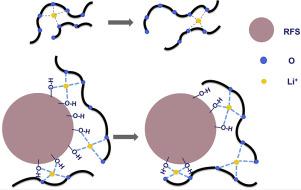Solid State Ionics ( IF 3.0 ) Pub Date : 2021-10-19 , DOI: 10.1016/j.ssi.2021.115768 Xin Wang 1 , Haiming Hua 1 , Xiaohua Xie 2 , Peng Zhang 3 , Jinbao Zhao 1

|
In this paper, the phenolic resin nano-spherical fillers (RFS) were added to PEO all-solid-state electrolytes, and the effect of surface groups (phenolic hydroxyl) of fillers on lithium ion conduction in PEO solid-state electrolyte was studied. It was found by AC impedance that the ion conductivity increased after adding 6% RFS (from 8.85 × 10−5 to 2.88 × 10−4 S cm−1 at 60 °C). It was unexpectedly found by DSC that RFS was different from traditional inert ceramics. It did not reduce the crystallinity of PEO in the matrix but lowered its the glass transition temperature, thereby increasing the ion conductivity. Infrared spectroscopy showed that the degree of complexation between Li+ and ether oxygen segment in PEO decreased after RFS was added. It is speculated that the lithium ion partly complexed with the oxygen atom of the hydroxyl group to form Li+ channels on the surface of RFS, and the effect of the hydrogen bond between the phenolic hydroxyl group and PEO can be ignored. The difference between the strength of this interaction is proved by theoretical calculation of its binding energy. Based on this, we propose that the hydroxyl group on the filler surface enhances lithium ion conduction mainly because the oxygen atoms in the hydroxyl group participate in the construction of lithium ion channels.
中文翻译:

填料表面的羟基促进了 PEO 全固态电解质中的 Li+ 传导
本文将酚醛树脂纳米球形填料(RFS)加入到PEO全固态电解质中,研究了填料表面基团(酚羟基)对PEO固态电解质中锂离子传导的影响。通过交流阻抗发现,添加6% RFS后离子电导率增加(60℃时从8.85×10 -5到2.88×10 -4 S cm -1)。DSC意外地发现RFS不同于传统的惰性陶瓷。它没有降低基体中 PEO 的结晶度,但降低了其玻璃化转变温度,从而提高了离子电导率。红外光谱表明,Li +加入RFS后PEO中的醚氧链段减少。推测锂离子部分与羟基的氧原子络合,在RFS表面形成Li +通道,酚羟基与PEO之间氢键的影响可以忽略不计。通过其结合能的理论计算证明了这种相互作用强度之间的差异。基于此,我们提出填料表面的羟基增强锂离子传导主要是因为羟基中的氧原子参与了锂离子通道的构建。











































 京公网安备 11010802027423号
京公网安备 11010802027423号